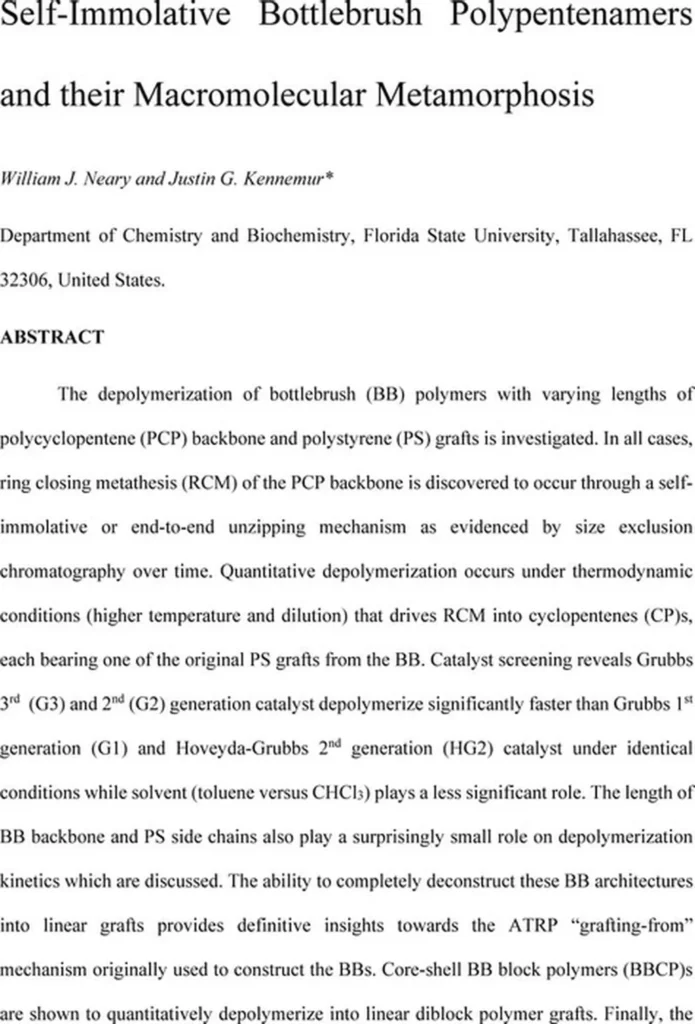In a groundbreaking development poised to reshape the landscape of functional polymers, a team of researchers has successfully synthesized a novel self-immolative bottlebrush polymer, demonstrating its potential to revolutionize the energy sector. The study, led by Marie Uth, details the creation of a unique polymer architecture that combines the self-destructive properties of self-immolative polymers with the versatility of brush-like polymer structures.
The research, published in the journal eXPRESS Polymer Letters (which translates to “Polymer Letters” in English), focuses on the synthesis and reactivity of a self-immolative poly(DL-dithiothreitol) backbone grafted with poly(glycidyl methacrylate) brushes. This innovative approach leverages activators regenerated by electron transfer–atom transfer radical polymerization (ARGET–ATRP), a controlled polymerization technique that allows for precise control over the polymer’s structure and properties.
The polymerization kinetics of the brushes were meticulously studied using 1H NMR and size exclusion chromatography, revealing a linear increase in the number-average molecular weight. This controlled growth is crucial for tailoring the polymer’s properties to specific applications. “The ability to fine-tune the molecular weight and architecture of these polymers opens up a world of possibilities,” Uth explained. “We can now design polymers that degrade on demand, which is particularly exciting for applications in energy storage and delivery systems.”
One of the most significant findings of the study is the retention of the self-immolative properties of the backbone in the final bottlebrush polymer. This means that the polymer can be triggered to degrade completely under specific conditions, leaving no toxic or harmful residues. This feature is particularly valuable for the energy sector, where the safe and efficient disposal of materials is a critical concern.
The potential commercial impacts of this research are vast. Self-immolative polymers could be used to create smart materials that respond to environmental stimuli, such as temperature or pH changes, making them ideal for use in sensors, actuators, and controlled drug delivery systems. In the energy sector, these polymers could be employed in the development of advanced batteries, supercapacitors, and other energy storage devices that require precise control over their degradation and disposal.
Moreover, the ability to graft functional side chains onto the self-immolative backbone allows for the creation of multifunctional polymers that can perform multiple tasks simultaneously. This versatility could lead to the development of new materials with enhanced properties, such as improved mechanical strength, thermal stability, and chemical resistance.
The research also highlights the importance of understanding the degradation process of these polymers. By examining the degradation behavior in solution, the researchers were able to gain insights into the mechanisms underlying the self-immolative process. This knowledge is crucial for designing polymers that can be reliably triggered to degrade under specific conditions, ensuring their safe and effective use in various applications.
The synthesis and reactivity of self-immolative pDTT-g-pGMA bottlebrush polymers represent a significant advancement in the field of functional polymers. The research led by Marie Uth demonstrates the potential of these materials to address critical challenges in the energy sector, from the development of advanced energy storage devices to the creation of smart materials that respond to environmental stimuli. As the field continues to evolve, the insights gained from this study will undoubtedly shape the future of polymer science and engineering, paving the way for innovative solutions to some of the most pressing challenges of our time.

